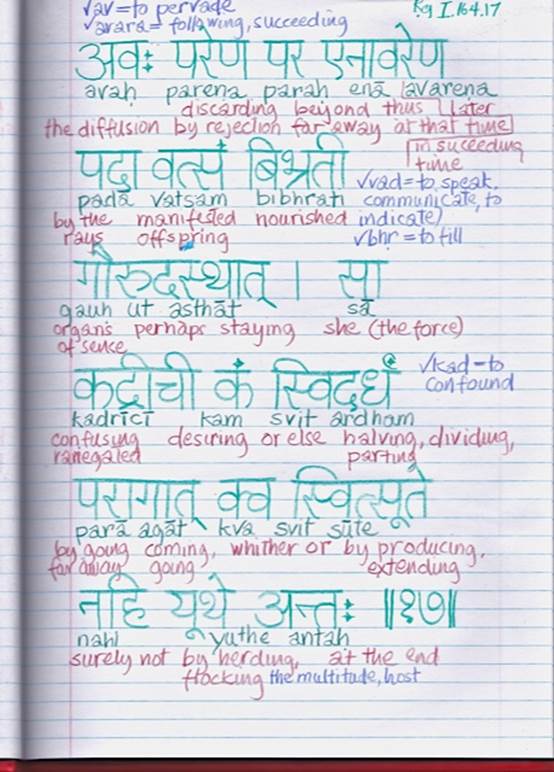
An intuitive translation of Rig Veda I.164.17 by V. Susan Ferguson
Rig Veda I.164.17
Leading beyond, extreme pleasing,
on the farther side of far distant space,
exceeding ancient past and future,
there beyond the constellation Capricorn,
in successive time, striding, a footstep,
the mark, the trace, vestige abode
of offspring manifested.
Bearing carrying the stars,
perhaps at once, sometimes
now and then, She
desiring our welfare, halved,
dividing, forming other parts,
the supreme Seven.
In what place, where,
what has become of her yielding,
procreating, begetting fortune.
Surely there is no limit, no boundary,
no end to the number, hosts and multitudes.

The Woven Universe
The essence of the ‘goddess’ as Matrix, Shakti-Maya, Prakriti emerged for me
in all Her radiant sublime Beauty in this verse. Instead of ray-cows giving
birth, I felt I was uncovering the vast unending spectrum of frequency
wave-forms, rivers of subtle energies weaving and coagulating in confluences
that give birth to all form. Here are some further insights into my
interpretative translation:
I.164.17
Leading beyond,
[Our efforts to comprehend the cosmos will lead us beyond ordinary
five-sense perception.]
extreme pleasing,
[This universe is the emanation, the arrangement and fruit of the One’s
Desire, Kama. The Sanskrit texts say that no man can overwhelm this Kama
that is all-powerful because it is God’s Desire. The creative manifesting
principle, Prakriti, the ‘goddess’ is the very essence, the effusion and
activating fragrance of the One’s Desire, Kama. As such, She is extremely
pleasing, lovely, enchanting, captivating and seductive in Her beauty, grace
and power, Shakti-Maya]
on the farther side of far distant space,
[The poet Rishi Dirghatamas is here creating the idea of realms ‘beyond’ for
his readers.]
exceeding ancient past and future,
[Thus beyond ‘successive’ Time.]
there beyond the constellation Capricorn,
[The Sanskrit word ‘enA’ is also defined as Capricorn. As one who has
studied astrology since I was in my 20s, the idea that the Rishis would
point to a constellation far beyond this earth to convey realms beyond the
ordinary of mankind seems perfect.]
in successive time, striding, a footstep,
[The Rishi Dirghatamas mentions ‘successive’ time as opposed to the
timeless, beyond time and thus eternal imperishable (akshara). Therefore we
are made aware of his knowledge of primordial metaphysical cosmology. In the
ancient Sanskrit texts, the tradition of Vishnu, meaning the ‘all-pervading’
creating the universe in ‘three steps’ as the dwarf is found in the Rig Veda
I.22.16-18 here quoted from the R.L Kashyap translation:
RVI.22.16-18: May the gods manifest their power in us from that place where
Vishnu strode, the seven stations or planes of the Earth. This
(all-pervading) Vishnu strode; thrice he placed his foot. In the dust of his
feet was all firmly established (thus the birth of the universe). Vishnu,
the unassailable and the guardian, strode superbly the three steps. He
upholds the law (Dharma) from here.]
the mark, the trace, vestige abode
[In the west we say ‘I follow in your footsteps’ to indicate someone who we
respect, who has made a mark in thought, word and their deeds. Such a
metaphorical footstep leaves a vestige, creating that trace for us to
emulate, an abode dwell in.]
of offspring manifested.
[So the multitude of marks, footsteps of the goddess, Prakriti, Shakti-Maya,
become the abode of Her manifested and vastly arrayed offspring.]
Bearing carrying the stars,
[Every being is born under their own unique confluence of planets in the
heavenly constellations. Yes, I mean astrology in its highest, most abstract
and esoteric sense. The meeting and interactions of vast constellations are
in fact the source of our individual blueprint, the map of our current
data-collecting vehicle generated in the moment of any birth, yours and
mine. We are holographic wave-forms woven in stellar energies. In our
current cycle of time, no one on this earth knows the source or how the
ancient art and science astrology came into being.]
perhaps at once, sometimes
now and then, She
[These two lines convey the idea the Prakriti, Shakti-Maya is beyond Time
and even unpredictable in Her power.]
desiring our welfare, halved,
dividing, forming other parts,
[Like any mother, the goddess loves Her children, in this case Her children
are the universe and everything within; therefore She desires our welfare.
In India, the goddess Lakshmi, who is the personification of a metaphysical
principle, is said to rule Fortune, luck, and wealth. Lakshmi is the wife of
the all-pervading Vishnu. When we need good fortune, Lakshmi is the lady to
turn to.]
the supreme Seven.
[Intuitively, I felt that this supreme Seven refers to the seven chakras,
each of which is correlated to a slice of the universal spectrum of
wave-forms. When we achieve greater self-mastery, the seven chakras activate
and allow us to access the entire universe.
R.L. Kashyap has this to say about these supreme Seven, which he terms the
Seven Stations: “According to the Rig Veda, Universal existence is arranged
in seven planes or stations consisting of the lower three, made of matter
(or Earth), midregion and Heavens, the upper three, made of Existence,
Knowledge and Bliss; and the fourth (middle) plane called as ‘svar’ which
links to two triples.” (R.L. Kashyap; Rig Veda Samhita, Mandala – 1, Part
One, Suktas 1-50; page 131-2).
On the highest level, what R.L. Kashyap has said above and my intuition
about the seven chakras is identical, the same, meaning one is a reflection
of the other.]
In what place, where,
what has become of Her yielding,
procreating, begetting fortune?
[The Rishi is declaring that Her ubiquitous presence will remain unknowable
to us — and simultaneously his unending desire to reach her essence.]
Surely there is no limit, no boundary,
no end to the number, hosts and multitudes.
[I think this one speaks for itself.]

R.L. Kashyap from Semantics of Rig Veda:
"The Sanskrit of Rig Veda is substantially different from the classical
Sanskrit of Kalidasa or even the Sanskrit of the Mahabharata. In Rig Veda,
the sandhi rules are not enforced with any rigidity; the meanings attached
to nouns are flexible... Many words widely used in Rig Veda...find no place
in classical Sanskrit. ... The current meanings of popular words such as...
gau (or go) (the animal cow) do not seem to be valid in many occurences in
Veda.
"The earliest study of the words in Veda is found in the book 'Nirukta' due
to Yaska...1000 BCE or earlier. ... He [Yaska] observes that 'grammar alone
will not be of help in understanding the Veda'. ...a mantra may have three
meanings...."

These are my usual notes with Shyam Ghosh's definitions.
Further word definitions:
avah – av = to favour, promote, satisfy, refresh; to offer; to lead to bring
to; to be pleased with, like accept favourably.
parena – far distant remote in space, beyond, on the farther side of,
extreme
para – ancient, past, later, future, ; more than, exceeding, superior or
inferior to, ; best, highest, supreme,
enA – here, there; in this manner, thus; then, at that time; black antelope,
deer; Capricorn; gazelle.
para enA = beyond ere; there;
beyond
avarena – below; following, in succeeding time
padA – a step, pace, stride; a footstep, trace, vestige, mark; abode, home,
position.
vatsam – offspring, manifested; calf
bibhrati – bearing, carrying (√bhri)
gauh - [explained above]
ut - aparticle of doubt or deliberation
asthAt – at once, (staying).
sA – she
kadrIcI – [kadru=a brown Soma vessel]; √kad – to confound; kad = now & then;
in no manner; sometimes.
kam – desiring
svit – luck, welfare
ardha – half, halved, forming half; one part, the other part, forming half;
dividing.
parA
agAt – [aga = not going; name of a mountain, tree, snake, sun, number seven]
kva – where?, in what place?, whither?; how is it with? What has become of?
svit – [svita = luck welfare]
sUte – procreate; produce,
bear, yield, beget, bring forth; [sUt = an imitative sound]
nahi – surely not, by no means, not at all, for not.
yUthe - yUtha = multitude,
number, host, herd, flock
antah – limit, boundary, end; in the end, at last, in the inside.

Sanskrit Dictionary
http://www.spokensanskrit.de/index.php
THE ROOTS, VERB-FORMS and PRIMARY DERIVATIVES of the SANSKRIT LANGUAGE, (A
Supplement to His Sanskrit Grammar, 1879), by William Dwight Whitney;
Motilal Banarsidass Publishers Pvt. Ltd, Delhi, 1963 - 2006.
A Concise Dictionary of Indian Philosophy, Sanskrit Terms Defined in
English, John Grimes; Indica Books, 2009.
Sanskrit-English Dictionary, M. Monier-Williams; Two volumes, Recomposed and
improved edition; Indica Books and Parimal Publications, New Delhi, 2008.
RIG VEDA SAMHITA: Mandala – 1 (Part Three), Suktas 122-191, (Text in
Devanagari, Translation and Notes), by R.L. Kashyap; Saksi, Published in
collaboration with ASR, Melkote; Sri Aurobindo Kapali Sastry Institute of
Vedic Culture, Bangalore, India, 2009.
Semantics of Rig Veda, by R.L. Kashyap; Sri Aurobindo Kapali Sastry
Institute of Vedic Culture, Bangalore, India, 2006.

| Questions
or comments about articles on this site: Email V. Susan Ferguson: Click Here |
Copyright© V. Susan Ferguson All rights reserved. |
Technical questions or
comments about the site: Email the Webmaster: Click Here |